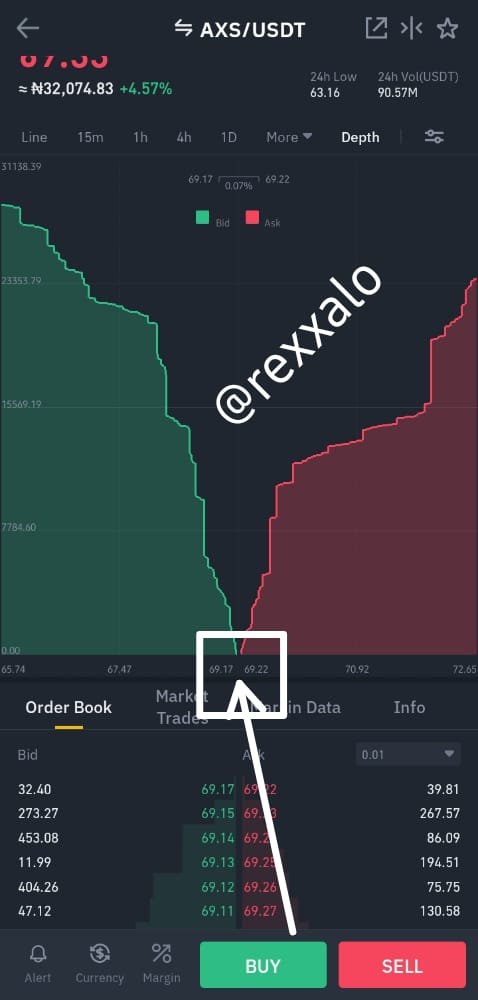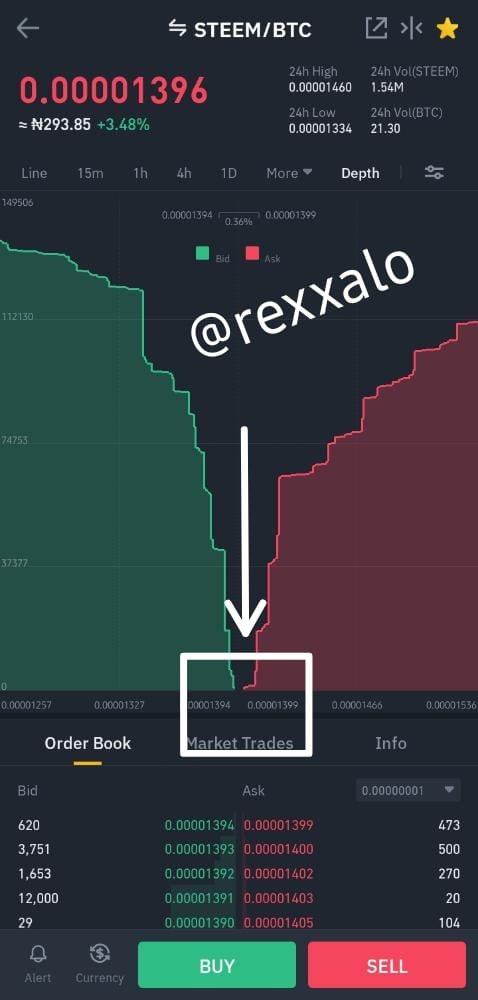.png)
Introduction
hi everyone, this new season has been really challenging, but i still find @awesononso class to be very informative. He taught about the Bid-ask spread and it's effect in everyday trading. It was something i really did not pay attention to, but thank goodness for the class. let's dive n to what we have shall we?
Questions to be answered
Properly explain the Bid-Ask Spread.
Why is the Bid-Ask Spread important in a market?
If Crypto X has a bid price of $5 and an ask price of $5.20,
a.) Calculate the Bid-Ask spread.
b.) Calculate the Bid-Ask spread in percentage.If Crypto Y has a bid price of $8.40 and an ask price of $8.80,
a.) Calculate the Bid-Ask spread.
b.) Calculate the Bid-Ask spread in percentage.In one statement, which of the assets above has the higher liquidity and why?
Explain Slippage.
Explain Positive Slippage and Negative slippage with price illustrations for each.

Properly explain the Bid-Ask Spread.

To properly explain the Bid-Ask Spread, We'd have to break it down, and properly explain all the terms involved in the clause. It is essential we properly understand the building blocks of the Bid-Ask Spread, starting from their definitions and implications.
Bid price

You know when you go to the local market, let us say you wish to get a new pair of shoes, you most definitely have a price in mind for the shoe you wish to acquire right? That price is what is known as the Bid price. Taking this to the crypto context, the bid price is the highest price that a buyer usually keeps in mind when planning to buy cryptocurrencies, in order to be guided not to under price or overprice a crypto asset.
Take for instance the peer to peer section in a crypto exchange platform. One thing you can notice is that all the prices listed are very identical, and this is because all the users willing to buy your coins make sure they stay close to the general bid price. This ensures that the buyers minimize loss when involved in a transaction.
Ask price

Imagine you had a really fast high-tech laptop, and something came up that caused you to inevitably need to sell it, you personally would consider how much you bought it, and this will affect how much you decide to sell it, you unconsciously or consciously decide on a price that you would want to sell it. That price decided on, that a seller is willing to sell at is known as the ask price.
Bringing this to the crypto context once again, The ask price is the minimum amount the seller is willing to accept to give up his assets. It is like the opposite of the bid price, and you can notice it's effect when we go the P2P section. You would notice that all the prices that the crypto asset is going out for are pretty organized and not too far apart. This is because of the established ask price for the asset.
So what is a Bid-Ask Spread?
Now that we have understood what the bid and ask prices are individually, we can now easily understand that the bid-ask spread is the difference between these two prices. Of course the prices must have a difference, even though sometimes in the case of certain crypto pairs, the difference is very small. Now one may ask "what is the significance of this bid-ask spread, and who stands to benefit from it?''
Well The personality who stands to make the most profit from a spread is the broker, The broker takes up their own commissions from these spreads, and depending on how much difference there is between the ask and bid price, the broker's profit is controlled. Also some traders might be miscalculation their trades, as they often leave out the bid-ask spread.

The image above is the Dept chart of the ADA/BTC pair, and I have zoomed in to properly examine the Bid-ask spread which resulted in showing me a 0.1% subtraction from trades, that is from every $10 profit, there is a minus of 0.1% that is $0.01.
One thing to take note of that affects spread is the trading volume available at the point. The higher the trading volume, the tighter the bid-ask spread. this is because there is more synchronization of the bid and ask prices when there are more assets available to trade with. The same way, the lower the trading volume the wider the bid-ask spread.

Why is the Bid-Ask Spread important in a market?

A risk indicator:
The Bid-ask spread shows the trader the how much risk he is taking on when going into a trade, because the higher the wider the spread, the more risky the trade might probably e, because the trader will have to rely on strong positive movements favoring his order in order to truly make reasonable profit from that trade.Long term cost importance:
The sum of money a trader will lose to the spread loss in a long period of time can be mindblowing. It might not seem like much while he constantly makes profit, but when records are checked in long term, these small percentages add up really fast.serves as order guide:
The bid-ask spread serves as a trader guide in the sense that a wider spread will cause the trader to be inclined towards inducing a limit order, while if the spread is not wide, a simple market order will be sufficient.Market direction indicator:
When the bid-ask spread narrows and widens, it indicates the direction of the market, as we have already discussed, more volume equals a tighter spread.liquidity measurement:
The Bid-ask spread is dependent on trading volume as we have already established, and we should know that the higher the trading volume, the more liquid the asset pair is. so in summary a higher liquidity equals a lower spread and a lower liquidity equals a higher spread.
r The Bid-ask spread for Steem/BTC is relatively wider, this is because of the low trading volume availabe.
r The Bid-ask spread for AXS/USDT is relatively thiner, this is because of the very high trading volume availabe.

a.) Calculate the Bid-Ask spread.
b.) Calculate the Bid-Ask spread in percentage./center>

values provided:
Bid price of Crypto X = $5
Ask price of Crypto X = $5.20
A. keepin in mind that Bid-ask spread = Ask price - Bid price
--->Bid-ask spread = $5.20 - $5 = $0.20
this implies that the Bid-ask spread of Crypto X is $0.20 or 20 cents.
B.
Bid-ask spread percentage = {Spread/Ask Price} X 100
and we have established that
- Spread = $0.20
- Ask Price = $5.20
so therefore, calculation for Bid-ask spread percentage = {$0.20/$5.20} X 100 = {0.03846} X 100
Bid-ask spread percentage = 3.846% or approximately 3.85%.

a.) Calculate the Bid-Ask spread.
b.) Calculate the Bid-Ask spread in percentage./center>

values provided:Bid price of Crypto Y = $8.40 and Ask price of Crypto Y = $8.80
A.
formula for Bid-ask spread = Ask price - Bid price
so therefore:- Bid ask spread = $8.80 - $8.40 = $0.40
Bid-ask spread of Crypto Y is therefore equal to $0.40 or 40 cents.
B
Bid-ask spread percentage = {Spread/Ask Price} X 100
as we have formerly established:
- Spread = $0.40
- Ask Price = $8.80
Bid-ask spread % = ($0.40/$8.80) X 100 = (0.04545) X 100 = 4.545%
- approximately the Bid-ask spread percentage of Crypto Y = 4.5%

In one statement, which of the assets above has the higher liquidity and why?

Crypto x has more liquidity because the Bid-ask spread is smaller and probably has higher trading volumes

Explain Slippage.

.png)
slippage in cryptocurrency refers to the incident where an order already placed within a price opens with a different price. If you have ever switched your stem dollar to stem, you might have noticed a lag, once in a while, this is because of the high volatility of the steem market. This implies that market slippage usually occurs within very volatile markets, but other factors like broadband speed can also lead to this mismatching order price.
Now Slippage is definitely not the same for all types of orders (was it to close an already open order or to make a new order) It is likely to occur when trading volume can not carry the Bid-ask spread at the order's specified prices, and maybe the orders are ones that require a large market.
We can therefore calculate slippage as price that order was placed - actual execution price and the slippage problem can be avoided using limit orders.

Explain Positive Slippage and Negative slippage with price illustrations for each.

Positive slippage
A positive slippage is a trader's friend, In the sense that it opens in a positive note. That is to say It opens Buy orders at even lower prices, and sell orders at higher prices. This means that the slip in price caused a move that was favorable for the traders in question, but it obviously can not be a positive slippage for everyone at once.
Price example
Let us assume that a trader makes a buy order for say steem at #200 and then the slippage occurs and opens the order at #155 this causes an instant gain of #5.
The same goes for a sell order, assuming the trader makes a sell order for steem at #150 and then the slippage occurs and opens the order at #205 this causes an instant gain of #10
Negative slippage
A negative slippage is a trader's enemy in the same sense,because it opens the order on a negative note. That is to say It opens Buy orders at even higher prices, and sell orders at lower prices. This means that the slip in price caused a move that was not favorable for the traders in question, but it obviously can not be a negative slippage for everyone at once.
Price example
Let us assume that a trader makes a buy order for say steem at #200 and then the slippage occurs and opens the order at #205 this causes an instant loss of #5.
The same goes for a sell order, assuming the trader makes a sell order for steem at #150 and then the slippage occurs and opens the order at #100 this causes an instant loss of #50

CONCLUSION

The bid-ask sread is very important and i am glad that this lecture has properly brought it to light for me. The crucial importance of knowing how the spread is affected by liquidity and volume availability, and the fact that the spread can actually guide a trader to make better trading decisions, including carving his risk management scheme is very mind blowing.
Special thanks to professor @awesononso for the awesome insightful lecture, i hope to see more of your classes, hopefully at a higher level, until then Adios Amigos!


Hello @rexxalo,
Thank you for taking interest in this class. Your grades are as follows:
Feedback and Suggestions
Great job on this! A good arrangement and clear explanations.
You just needed a little work on the slippage question.
Thanks again as we anticipate your participation in the next class.
Downvoting a post can decrease pending rewards and make it less visible. Common reasons:
Submit
Thanks professor @awesononso
Downvoting a post can decrease pending rewards and make it less visible. Common reasons:
Submit